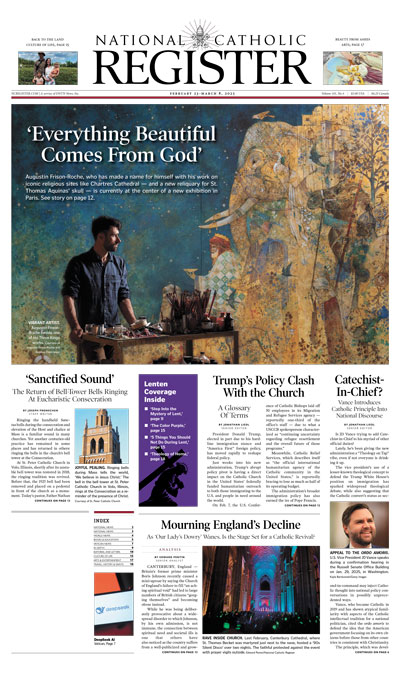Thirsting for Love: An Easter Season Meditation
COMMENTARY: Like the Samaritan woman, we are intrigued by the notion of never thirsting again.

When my sister and I were toddlers, we played in a courtyard that was two stories below our family’s residence. Our mother would occasionally look out the window to check on us, but generally we were left to our own devices. At some point, thirst would strike and we would start yelling: “Mommy, we want a drink of water!”
Rather than walk downstairs, however, she invented an ingenious plan: She took plastic cups of water, tied ropes around them and lowered them down to her children. Once we’d satiated our thirst, we tugged on the rope, and she lifted the cups back into the kitchen.
During this Easter season, I think of those days long ago whenever I read the passage in Scripture where Jesus says, “I thirst.” He had been imprisoned overnight without food or water and then beaten and pierced with nails. Dehydrated from the loss of blood, he experienced an intense, painful thirst.
The words “I thirst” are displayed on the walls of every chapel in the world run by the Missionaries of Charity, the religious order founded by Mother Teresa. In a meditation that she authored, she understood Jesus’ thirst as a longing for our love and our salvation. The sisters sing a lovely hymn with the words: “Sweet Lord, thy thirst for souls, I satiate with my burning love, all for thee.”
When Jesus cried out on the cross, the soldiers interpreted his words as a physical need for water. However, St. John delves more deeply, telling us these words were spoken to fulfill Scripture. This statement about thirst evokes Psalm 69: “They gave me gall for food, and for my thirst they gave me vinegar to drink.”
Beaten, humiliated and pierced, Jesus was in excruciating pain, and he could have begged for someone to get him down, for someone to stop the agony. Many men who were crucified cursed the crowd so viciously that the soldiers cut out their tongues to silence them. However, Jesus had just shocked the crowd by forgiving his tormentors, rather than cursing them. And his words “I thirst” echo down through the centuries, filled with mystical meaning.
The spiritual theme about thirst was conveyed when Jesus met the Samaritan woman at Jacob’s well. He began by saying, “Give me a drink.” She had a bucket and a rope, which he lacked, to draw water from the well. Her life was difficult, since she had to walk each day to the well, draw water and haul it back. No wonder she’s intrigued when Jesus moves the conversation to a higher level, telling her about living water that would quench her thirst forever. “Sir, give me this water, that I may not thirst, nor come here to draw,” she says. As they continue to talk, she realizes he is referring to more than quenching mere physical thirst.
The theme of Jesus spiritually satisfying our thirst is also mentioned in John 7:37: “If anyone thirst, let him come to me and drink. He who believes in me, as the Scripture has said, ‘Out of his heart shall flow rivers of living water.’”
At another time, Jesus said, “I am the bread of life; he who comes to me shall not hunger and he who believes in me shall never thirst” (John 6:35).
Jesus told his disciples that anyone who gave a cup of water “to these little ones” because he is a disciple “will by no means lose his reward” (Matthew 10:42). It is so simple. It just takes a cup of water, the same amount that would have relieved some of Jesus’ agonizing thirst on the cross.
Jesus’ first miracle was changing ordinary water into an extraordinarily delicious wine. Water into wine, wine into blood, bread into flesh, death into life. We can’t live without water, and we can’t have eternal life without quenching our thirst with the Blood of Christ. He said, “Whoever eats my flesh and drinks my blood will have life in him, and I will raise him up on the last day.”
For doubters who balk at wine becoming blood and bread becoming flesh, we can ask: What about God becoming man? What about death leading to life? Is there a limit on miracles for God?
Some people thirst for riches and power, while others long for beauty, youth and admiration. Everything on earth we thirst for ultimately fails us. Beauty fades, riches disappoint and power corrupts.
We cannot grasp the unbearable pain of having nails driven into our flesh. We cannot imagine the horror and suffering connected with the viciousness of scourging.
Still, we have experienced intense thirst. We have all been children crying in the middle of the night for a glass of water. We have all thirsted in a symbolic way for the wrong things like fame, money and power.
Like the Samaritan woman, we are intrigued by the notion of never thirsting again. This is what Jesus offers us in the secret depths of our hearts — an end to hunger, an end to pain, an end to grief, an end to thirst. He offers us the Kingdom, where God will wipe every tear from our eyes.
Revelation assures us, “Never again will they hunger, never again will they thirst.”
Especially during this Easter season, let us resolve to imitate the Missionaries of Charity, who strive to quench the thirst of Jesus Christ with a profound love and sweet devotion.
- Keywords:
- easter season
- missionaries of charity
- i thirst

















